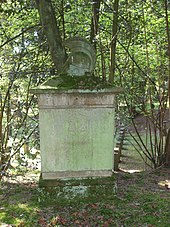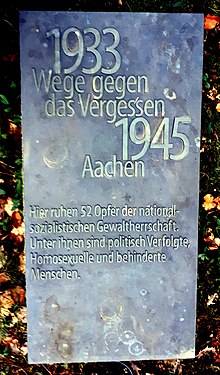Forest cemetery (Aachen)
The Aachen Forest Cemetery is an approximately 30.5 hectare cemetery in the city of Aachen , which is integrated into the neighboring Aachen Forest in the south of Burtscheid . The origins go back to the year 1832 and it is divided into a general cemetery area and a cemetery of honor , both of which form a common, partially seamless unit. Joint access to this facility is possible all day, both from the Monschauer Straße leading out of town opposite the II.-Rote-Haag-Weg as well as via the connected forest car park with public transport stop on Monschauer Straße and from Kornelimünsterweg. In the southern part of the cemetery rises the outfall forest cemetery, which flows north through the Nellessenpark and joins the Beverbach on the left beyond the Eselsweg .
Origins
In the years 1831/32, 1849 and 1866 there were several massive cholera epidemics in the greater Aachen area and above all in the then independent town of Burtscheid, as well as strange cases of intermittent fever , also known as "Burtscheid's disease" during the same period . This resulted in numerous deaths, for which a cemetery was set up outside Burtscheid in the neighboring city forest in 1832, which for this reason was initially also called a cholera cemetery. After the hot mountain cemetery Burtscheid / Aachen was laid out in 1862 and the city of Aachen itself set up the Westfriedhöfe I. and II. In 1899/90 , the cholera cemetery was initially no longer occupied after the epidemics had subsided. Instead, the Aachen Bismarck Tower was later built on the site , which was inspired by the Aachen student body of the Technical University of Aachen and influential citizens and inaugurated on July 22, 1907.
Cemetery of honor
With the beginning of the First World War and the associated first deaths in the Aachen area, the city of Aachen was looking for a way to bury them in an appropriate manner. As a result, with a council resolution of September 12, 1914, on the site of the former cholera cemetery around the Bismarck Tower, an area of approximately 8.6 hectares was converted into a cemetery of honor exclusively for victims of war and tyranny.
After the first war victims had been buried there at the beginning of August, the first official burial took place on September 25, 1914. By January 1923, 2,455 German and foreign war dead were buried in the Ehrenfriedhof, most of whom had died as wounded and sick soldiers in the Aachen hospitals and military hospitals .
Within this cemetery of honor, an approximately 15 m² area on a 1.50 m high rise in the ground was set up as a Jewish cemetery , which was only occupied from 1914 to 1918 and on which 16 tombstones ( mazewot ) are currently preserved. Most of the stones are weathered and illegible, but two of them have an engraved Star of David .
A few weeks after the outbreak of the Second World War , on November 1, 1939, the city of Aachen had to expand the cemetery and create new burial grounds for the first fallen. In the years 1939 to 1945, another 2,623 registered war dead were buried here. A total of 5,078 recognized war dead from 16 nations rest on this largest war cemetery in the former administrative district of Aachen , including 4,796 Germans, 235 Russians, 15 Romanians, 11 Serbs, 7 Poles, 3 Dutch, 2 Belgians as well as one French, one Austrian, one Spanish, one Hungarian, Yugoslav, Turk, Ukrainian, Indian and Canadian. In addition, various Aachen interest groups and associations, such as the Aachen gymnastics and sports club, the butchers and butchers' guild, the professional fire brigade, the Aquisgrana Association of Catholic Merchants or the Orphea men's choir, commemorate their members who died in the war here on their own plots.
Even after the war, other deceased people were transferred who had been buried elsewhere in the meantime. In 1961 the last major reburial took place with 104 war dead, among them numerous women, men and children who had found their final resting place as bomb victims of the city of Aachen in the neighboring forest cemetery. In addition, 52 concentration camp victims , mostly politically persecuted, homosexual and disabled, whose urns were reburied from other facilities on the war cemetery in August 1962 . For the central memorial square, a 6.20 m high stone cross made of Belgian granite was erected in the middle of the cemetery of honor as early as 1957. This was originally donated for the military cemetery in Ougrée-Boncelles near Seraing , where the German fallen soldiers were buried, but after they were reburied in other cemeteries, it came to Aachen.
In addition, both the grave field with the 52 concentration camp victims and the central memorial at the Hochkreuz were included in the Ways Against Forgetting project at the Volkshochschule Aachen and given a plaque. On it is written:
“52 victims of the National Socialist tyranny rest here. Among them are politically persecuted and disabled people. "
and
“The German striving for power resulted in two world wars in the 20th century. The Second World War alone cost the lives of more than 62 million people. Almost 4,000 Aacheners died as soldiers for Nazi Germany, 2,500 Aacheners perished in their city. "
Every year on the day of national mourning , the Volksbund Deutsche Kriegsgräberfürsorge , the city region of Aachen and the local eldest of Aachen organize a memorial service for the deceased of both world wars on the area of the cemetery of honor .
Forest cemetery - common area
After the population of Aachen had increased significantly between the world wars and other cemeteries gradually reached their capacity limits, a general cemetery was set up immediately after the Ehrenfriedhof from 1930, which was also fully integrated into the city forest and covered an area of around 22 hectares. The associated sanctuary was completed in 1933.
In addition to the standard single, double and row graves, various types of graves for natural burial have been offered here since 2004 , which were approved by the adoption of the new North Rhine-Westphalia Funeral Act of September 1, 2003. This includes graves for the near-natural burial of biodegradable urns in the forest area of the cemetery with up to two urns in the root area of a tree, which can be identified by a name with a lying, near-natural memorial stone per grave. These types of graves are maintained by the Aachen city authority. In addition, there is also the option of natural anonymous burials at the forest cemetery.
Individual graves (selection)
- Ludwig Beltz , internist and medical director at the city hospitals in Aachen
- Heinrich Bischoff , Belgian Germanist and literary critic
- August von Brandis , professor of figures and landscape drawing
- Emil Ciocoiu , Romanian painter
- Winfried Dahl , materials scientist
- Ilse Essers , engineer
- Helmut Faissner , physicist and rector of RWTH Aachen
- Georg Frentzen , architect and university professor
- Wilhelm Fucks , physicist and rector of RWTH Aachen
- Brigitte Gilles , psychologist and first women's representative at RWTH Aachen
- Walter Grösser , electrical engineer and university professor
- Hans-Jürgen Haubrich , electrical engineer and university professor
- Gisbert Kranz , writer, educator and Catholic theologian
- Jacques Königstein , Aachen carnivalist and founder of the order against seriousness
- Manfred Lossau , classical philologist and university professor
- Albert Maas , former Lord Mayor of Aachen
- Peter Mennicken , Professor of Philosophy
- Bernd Monheim , industry manager
- Heinrich Mückter , pharmacologist and chemist
- Reinhold Munzenberg , soccer player and President of Alemannia Aachen
- Hans-Dieter Ohlenbusch , biochemist and rector of RWTH Aachen
- Erwin Patzke , botanist
- Eugen Piwowarsky , materials scientist and university professor
- Andreas Ploeger , Professor of Medical Psychology
- Klaus Poeck , professor of neurologist
- Franz Pöggeler , Professor of Education
- Wilhelm Rombach , retired Lord Mayor D. of the city of Aachen
- Bernhard Sann , mining farmer and rector of RWTH Aachen
- Christopher Schlick , Director of the Institute for Ergonomics at RWTH Aachen University
- Hubert Schmitt-Degenhardt , District President of the District of Aachen
- Egon Schmitz-Cliever , medical historian
- Martin Staemmler , pathologist
- Christian Stetter , linguist and university professor
- Dirk Vallée , university professor for urban planning and urban traffic at RWTH Aachen
- Withold Wiechowski , electrical engineer and university professor
- Paul Wilski , geodesist and surveyor
See also
Web links
- 100 years cemetery of honor brochure of the city of Aachen
- Brief information on the forest cemetery and honor cemetery on the website of the city of Aachen
Individual evidence
- ↑ Egon Schmitz-Cliever : The cholera epidemic in Alt-Aachen and Burtscheid , In: Journal of the Aachen History Association , vol. 64-655 (1951-52) p. 120-167
- ^ Jewish cemetery Waldfriedhof Aachen
- ↑ Memorial plaque Aachener Turn- und Sportverein
- ↑ Memorial plaque butcher and butcher guild
- ↑ Commemorative plaque professional fire brigade
- ^ Memorial plaque for the Association of Catholic Merchants Aquisgrana
- ↑ Orphea men's choir memorial plaque
- ^ Relocation of concentration camp victims
- ^ Cemetery and Funeral Ordinance NRW
Coordinates: 50 ° 44 ′ 49.4 " N , 6 ° 6 ′ 34.5" E





